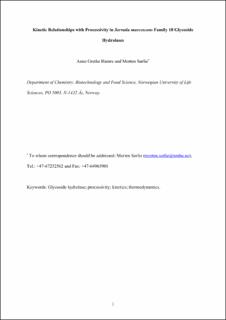Kinetic relationships with processivity in Serratia marcescens family 18 glycoside hydrolases
Peer reviewed, Journal article
Accepted version
Permanent lenke
https://hdl.handle.net/11250/2680014Utgivelsesdato
2019Metadata
Vis full innførselSamlinger
Originalversjon
Biochemical and Biophysical Research Communications - BBRC. 2019, 521 (1), 120-124. 10.1016/j.bbrc.2019.10.089Sammendrag
In nature, recalcitrant polysaccharides such as chitin and cellulose are degraded by glycoside hydrolases (GH) that act synergistically through different modes of action including attack from reducing-end and nonreducing-end (exo-mode) and random (endo-mode) on single polysaccharide chains. Both modes can be combined with a processive mechanim where the GH remain bound to the polysaccharide to perform multiple catalytic steps before dissociation into the solution. In this work, we have determined association rate constants and their activation paramaters for three co-evolved GHs from Serratia marcescens (SmChiA, SmChiB, and SmChiC) with an oligomeric substrate. Interestingly, we observe a positive correlation between the association rate constants and processive ability for the GHs. Previously, a
positive correlation has been observed between substrate binding affinity and processive ability. SmChiA with highest processive ability of the three GHs bind with a kon of 11.5 ± 0.2 µM-1s-1, which is five-fold and 130-fold faster than SmChiB (less processive) and SmChiC (nonprocessive), respectively.

